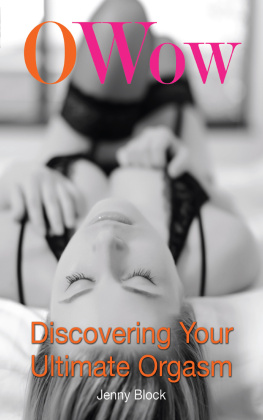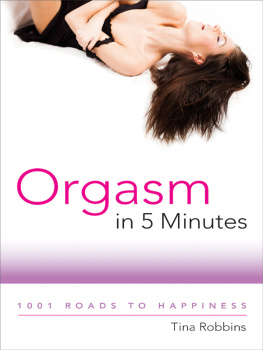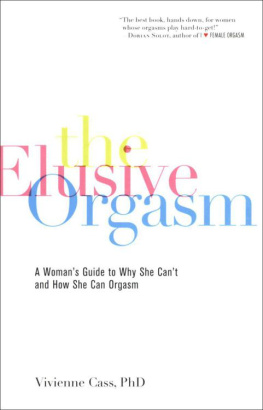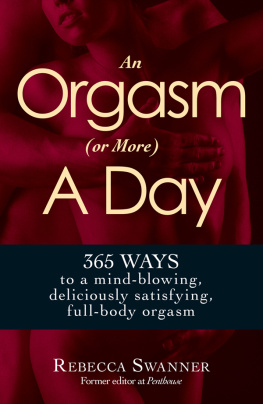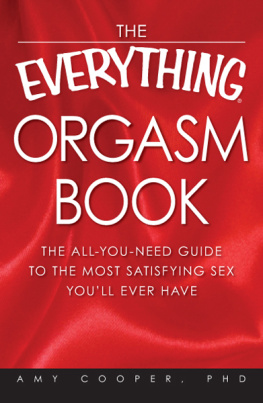The ORGASM ANSWER GUIDE
The ORGASM
ANSWER GUIDE
Barry R. Komisaruk
Beverly Whipple
Sara Nasserzadeh
Carlos Beyer-Flores

2010 The Johns Hopkins University Press
All rights reserved. Published 2010
Printed in the United States of America on acid-free paper
2 4 6 8 9 7 5 3 1
The Johns Hopkins University Press
2715 North Charles Street
Baltimore, Maryland 21218-4363
www.press.jhu.edu
Library of Congress Cataloging-in-Publication Data
The orgasm answer guide / Barry R. Komisaruk ... [et al.].
p. cm.
Includes bibliographical references.
ISBN-13: 978-0-8018-9395-7 (hardcover : alk. paper)
ISBN-10: 0-8018-9395-X (hardcover : alk. paper)
ISBN-13: 978-0-8018-9396-4 (pbk. : alk. paper)
ISBN-10: 0-8018-9396-8 (pbk. : alk. paper)
1. OrgasmPopular works. I. Komisaruk, Barry R.
QP251.O74 2009
613.96dc22 2009009804
A catalog record for this book is available from the British Library.
Special discounts are available for bulk purchases of this book. For more information, please contact Special Sales at 410-516-6936 or specialsales@press.jhu.edu.
The Johns Hopkins University Press uses environmentally friendly book materials, including recycled text paper that is composed of at least 30 percent post-consumer waste, whenever possible. All of our book papers are acid-free, and our jackets and covers are printed on paper with recycled content.
Preface
WHEN YOU WORK IN the field of sexual health, you are asked a lot of questions. Sometimes you know the answer, sometimes you need to call on colleagues for advice. This book is a combination of our knowledge and the assistance we have received from many people. We are grateful to all those who have posed questions to us throughout the years and especially to the following people, who helped us before and during the writing of this book: Rachel Abrams, John Bancroft, Edwin Belzer, Wendy Birbano, Karen Brash-McGreer, Maria Cruz Rodriguez del Cerro, Arlene Feldman, Eleni Frangos, David Goldmeier, Gabriela Gonzalez-Mariscal, Cynthia Graham, Serin Kelami, Harvey Kliman, Roy Levin, Christine McGinn, Angelica Montiel-Breton, Michael Perelman, Martha Rivera, Jay Rosenblatt, Kenneth Ray Stubbs, Alexander Tsiaras, Mary Ann Ulrich, Nan Wise, and Kevan Wylie. Without their assistance, this book would never have been possible. We also acknowledge, with special thanks, our editor, Vincent J. Burke, for his continuous encouragement, support, thoughtfulness, and expert advice and help. We offer our sincere gratitude to Linda Strange, our copyeditor, for her excellent unruffling of our text.
We think the diversity of our professional and personal backgrounds helps make the book both readable and comprehensive. Professionally,among the four authors we have some level of expertise in virtually every aspect of sexual health related to orgasm. Personally, we are a diverse religious and cultural mixChristian, Jewish, and Muslim; American, Middle Eastern, and Mexican.
After numerous conversations among the four of us, we settled on eighty or so questions that represent what we think you are curious about. Some of our answers are brief, others more detailed. We tried to answer the questions without getting bogged down in scientific details, but we also tried not to leave out important information--even if it meant including the occasional medical term. We tested the manuscript on both experts and non-experts and, we hope, have produced a book that satisfies both groups.
Researching and writing a book takes you away from the ones you love for far too many hours of the day. For their understanding and support, Barry thanks his sons, Adam and Kevin, and, in remembrance, his wife, Carrie. Beverly thanks her husband, Jim, children, Allen and Susan, and grandchildren, Kayla, Travis, Valerie, William, and Elyse. Sara thanks her husband, Pejman Azarmina. Carlos thanks his wife, Josefina, and daughters, Maria Emilia and Gaby.
The ORGASM ANSWER GUIDE
One
About Orgasms
What are orgasms?
AS SIMPLE AS THIS question sounds, and as obvious as the answer may seem to most of us, defining orgasm can prove difficult. In some ways, it is as difficult to define orgasm as it is to describe how something tastes.
Lets begin to explore the meaning of the word orgasm by looking at its linguistic origin, the Greek word orgasmos, which is defined as to swell as with moisture, be excited or eager (Oxford English Dictionary). Alternatively, we could use the more technical definition offered in the Kinsey Reports: The expulsive discharge of neuromuscular tensions at the peak of sexual response. An even more technical description was offered by the research team of Masters and Johnson: A brief episode of physical release from the vasocongestion and myotonic increment developed in response to sexual stimuli.
Perhaps the most interesting of all characterizations is the one that was offered by John Money, who, with his colleagues, wrote the following description of orgasm: The zenith of sexuoerotic experience that men and women characterize subjectively as voluptuous rapture or ecstasy. It occurs simultaneously in the brain/mind and the pelvic genitalia. Irrespective of its locus of onset, the occurrence of orgasm is contingent upon reciprocal intercommunication between neural networks in the brain, above, and the pelvic genitalia, below, and it does not survive their disconnection by the severance of the spinal cord. However, it is able to survive even extensive trauma at either end.
So, what are orgasms? Here is our broad definition: an orgasm is a buildup of pleasurable body sensations and excitement to a peak intensity that then releases tensions and creates a feeling of satisfaction and relaxation.
Do men and women have the same sensations during an orgasm?
NOBODY CAN REALLY FEEL someone elses pleasure, so comparisons of the sort implied by this question are difficult to make. However, the following experiment was a clever way of getting at the question. Researchers Vance and Wagner, in 1976, asked college students to write descriptions of their own orgasms, and a group of judges tried to guess which descriptions were written by men and which by women. The judges were a mix of female and male obstetrician-gynecologists, psychologists, and medical students. Before submitting the descriptions to the judges, the researchers substituted gender-neutral words for gender-specific words in the students written descriptions (such as genitalia for penis or vagina) to intentionally conceal the sex of the writers.
The researchers found that the judges were unable to distinguish the sex of a person from that persons written description of his or her orgasm.
The students descriptions are vivid, as demonstrated by the following quotations, selected at random from the responses of six of the forty-eight participants in the study:
- A sudden feeling of lightheadedness followed by an intense feeling of relief and elation. A rush. Intense muscular spasms of the whole body. Sense of euphoria followed by deep peace and relaxation.
- Feels like tension building up until you think it cant build up any more, then release. The orgasm is both the highest point of tension and the release almost at the same time. Also feeling contractions in the genitals. Tingling all over.
- There is a great release of tensions that have built up in the prior stages of sexual activity. This release is extremely pleasurable and exciting. The feeling seems to be centered in the genital region. It is extremely intense and exhilarating. There is a loss of muscular control as the pleasure mounts and you almost cannot go on. You almost dont want to go on. This is followed by the climax and refractory states.
Next page




